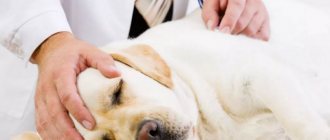Owners who have recently purchased a four-legged friend are wondering why the dog is breathing frequently and whether this is a sign of a serious illness. The symptom may relate to pathological or physiological manifestations; veterinarians recommend not to take risks and seek professional help in a timely manner.
Rapid breathing in a dog
How does a dog's respiratory system work?
Diseases in any part of the respiratory system and even other parts of the body can lead to breathing problems in dogs.
The respiratory system is made up of many parts, including the nose, mouth, throat (pharynx and larynx), airways (trachea), and lungs. Air is drawn in through the nose or mouth and then transferred to the lungs through a process called inhalation. In the lungs, oxygen is transferred to red blood cells. Red blood cells carry oxygen to the rest of the body.
While oxygen is transferred to the red blood cells, carbon dioxide is transferred from the red blood cells to the air in the lungs. It is then expelled through the nose or mouth through a process called exhalation.
When not to worry
In the absence of pathology, rapid breathing in dogs is associated with physiological characteristics and weather conditions. After certain factors disappear, it stabilizes. Constancy is acceptable in a number of breeds.
Anatomical features of some breeds
Small dogs have a fast metabolism and an increased heart rate, so their breathing rate is higher. Dyspnea is also common in brachycephalic breeds with a short muzzle. Due to the unnatural shape of the skull, narrowed nostrils and short soft palate, they often suffer from upper respiratory tract diseases.
Brachycephalic breeds include pugs and Pekingese. They have difficulty drawing air through their sinuses, so they snore constantly. Brachycephalics also overheat very quickly and stick out their tongues in an attempt to cool the body.
Spitz dogs behave very strangely. Their peculiar structure of the larynx leads to “reverse sneezing” syndrome during times of stress and illness. This “sneeze” resembles a cough and increases the frequency of breathing movements.
Rapid breathing in pregnant and lactating bitches
Rapid breathing in a pregnant dog occurs shortly before giving birth and disappears soon after the puppies appear. This occurs due to pain and stress. If the condition does not return to normal, contact your veterinarian.
In the first 2 days after birth, eclampsia may occur, a fatal condition that increases blood pressure. In addition to shortness of breath, it is accompanied by photophobia and loss of coordination. During a difficult birth, the placenta or fetus may become stuck in the uterus. A simple operation will be required to remove them safely.
Anxious dream
The restless behavior of a sleeping animal, accompanied by shortness of breath, rapid heartbeat and active movements of the paws, is the result of the manifestation of emotions during a colorful dream. It is also possible for the soft palate to recede, interfering with normal respiratory movements.
Heat or high physical activity
Dogs often breathe with their mouths open in hot weather, after intense training or active play. With these factors, the minute frequency of breaths can increase to 160.
Try to avoid frequent and prolonged overheating. They negatively affect the liver and can lead to the death of the animal.
Reaction to vaccination
Frequent breathing in a dog after vaccination indicates the activity of the immune system. Temporary lethargy, loss of appetite and a slight increase in temperature are acceptable during the first 24 hours.
For safety, it is recommended to sit in the veterinary clinic for about half an hour after the procedure. This is necessary to monitor allergic reactions in the form of asphyxia (suffocation).
Breathing and respiratory rate for dogs
Distinguishing between a dog that is breathing normally and a dog that is having breathing problems is not always as easy as it may seem. At rest, healthy dogs should have a breathing rate of 20 to 34 breaths per minute and should not exert much effort to breathe. Of course, dogs may breathe more quickly and/or more deeply in response to normal factors such as increased temperature, exercise, stress and excitement.
Owners need to get a feel for what is normal for their dogs before any health problems arise. How does your dog breathe when resting, walking, or after vigorous play? With this knowledge, you can sense subtle changes in your dog's breathing rate and abnormal breathing before a crisis develops.
Shortness of breath in dogs
When dogs work harder to breathe than circumstances require, they are said to be dyspneic. Breathing problems may occur when you breathe in (inhalation shortness of breath), when you breathe out (exhalation shortness of breath), or both. Common symptoms include:
- The walls of the chest, and sometimes the abdomen, will move more than usual when breathing
- Nostrils may open when breathing
- Breathing with your mouth open (but not necessarily panting)
- The neck and head drop down and extend
- Noisy breathing
Hard breath
Panting may be a normal way for dogs to cool down in response to exercise or heat, or it may be a sign of a breathing problem.
Heavy breathing in dogs is characterized by:
- Rapid breathing
- Usually shallow breaths
- Wide open mouth
- Extended language
Some dogs develop a combination of breathing problems (such as expiratory dyspnea and tachypnea) or other symptoms such as coughing, depending on the underlying problem.
Prevention of illness
Compliance with the rules and regulations for keeping him will help prevent the development of such a pathology in your four-legged friend. For example, lung diseases, as a rule, arise due to an infectious lesion of the body and it does not matter whether it is a direct pathology or the result of a complication of another ailment.
Therefore, protecting your pet from infectious agents is the main principle of preventing respiratory diseases. Therefore, it is always important: to adhere to regular examination of the pet, both by the owner himself (identifying various changes), and clinically, which will determine the pathology if something happens; at the slightest suspicion, perform an analysis for infectious lesions;
- do not refuse preventive vaccinations against diseases common in the region;
- Once a quarter, and in the summer much more often, treat against helminths.
Creating optimal conditions for keeping a pet is considered equally important. After all, inflammation of the respiratory system more often occurs in dogs that are kept in drafts, in cold, damp rooms. In this case, in the fall, especially their guard breeds, begin to cough heavily.
Spring is no less dangerous for animals, when allergic reactions can worsen against the background of plant pollen or poplar fluff. So if rapid breathing occurs in dogs, the causes should be looked for immediately and try to eliminate them. But when the owner himself cannot solve the problem, there is a reason to immediately seek veterinary help. It is important to always remember that there is no serious canine pathology that causes wheezing that can be treated at home.
Causes of difficulty breathing in dogs
Causes of difficulty breathing in a dog may include the following:
- shortness of breath in dogs
- nose diseases
- small nostrils
- infection
- tumors
- foreign body
- throat diseases
- elongated soft palate
- tracheal collapse
- lung diseases
- infection (such as a fungal infection)
- heart failure with fluid in the lungs (pulmonary edema)
- heart enlargement
- disease associated with heartworm infection
- bleeding or bruising of the lungs
- electric shock
- injury
- inflammatory diseases (for example, chronic bronchitis)
- heart failure with fluid around the lungs (pulmonary effusion)
- air accumulation
- partial paralysis of the chest wall (eg, tick paralysis, trauma)
- damage to the diaphragm (eg, traumatic rupture)
- congenital hernias
- muscle diseases
- diseases that cause the stomach to press on the diaphragm enlargement of the liver, stomach or spleen
- stomach full of air (bloating)
- fluid in the abdomen (ascites)
- tumors
Tachypnea (rapid breathing) in dogs has causes
- Low oxygen levels in the blood (hypoxemia)
- Low red blood cell count (anemia)
- Blood clots inside blood vessels in the lungs
- Causes of shortness of breath in dogs can also lead to tachypnea
A dog may choke if it experiences:
- pain
- anxiety
- drug poisoning
- high body temperature
- metabolic acidosis (when the body produces too much acid or cannot remove it normally)
- obesity
- high blood pressure
- high thyroid hormone levels
- some of the causes of wheezing and tachypnea in dogs can also lead to wheezing
When increased breathing can be considered a deviation
Pathological symptoms, manifested by problems with the free passage of air through the nasopharynx, require immediate contact with a veterinarian. The chances of saving the animal depend on this, especially if clinical manifestations become more pronounced over time.
Frequent breathing as a symptom of illness
Pathological lesions of the respiratory system are common root causes of the development of anomalies. Symptoms warn of the formation of:
- inflammatory and infectious diseases of the nasopharynx with severe swelling of the mucous membranes and narrowing of the nasal passages;
- neoplasms of benign or malignant etiology;
- changes in the structure of the soft palate;
- edema, paralysis, tumors and stuck foreign objects in the pharynx and trachea;
- bronchitis, pneumonia, tumor-like processes, torsion of the lobes of the lung, closure of the pulmonary canals by helminths - with lesions in the bronchopulmonary region;
- pneumothorax, hydrothorax - with accumulation of air or fluids in the lungs;
- diaphragmatic hernia.
Other systemic diseases that do not affect the respiratory region and have a typical clinical picture are presented:
- pathologies of the heart muscle, arrhythmia and other disorders;
- damage to the endocrine system with subsequent hormonal imbalance and the development of diabetes mellitus, Cushing's syndrome, with constantly elevated levels of cortisol in the bloodstream;
- anemia;
- pathological increases in the volume of internal organs, accumulation of liquids or gases, cancer or non-cancerous tumors.
Important! Breathing may become faster due to dehydration or fever.
Polyp proliferation
Diagnosis of breathing problems in dogs
Difficulty breathing can be life-threatening, and your dog should be examined by a veterinarian as soon as possible. You will need to provide details about your dog's medical condition, the onset of symptoms, and possible incidents that may have preceded the condition.
During the examination, your veterinarian will carefully watch your dog's breathing and listen to his chest for specific sounds that may help identify a problem. The color of your dog's gums will also be assessed, as the color of the gums can indicate whether your dog has adequate blood flow and oxygenation.
Your veterinarian may try to make your dog cough. If your dog is having extreme difficulty breathing, your veterinarian will give him oxygen before doing any tests.
Initial diagnostic testing for dogs that have breathing problems may include a complete blood count, biochemical profile, stool examination, urinalysis, and chest x-ray. Additional procedures and testing may also be necessary. These may include ultrasound imaging, an electrocardiogram, specialized blood tests, analysis of fluid samples, rhinoscopy or bronchoscopy (using an endoscope to look inside the nose or airway, respectively), surgery, and tissue biopsy, depending on the specifics of the dog's condition. Given the range of possible reasons that can lead to your dog’s rapid breathing, you need to understand that self-medication is impossible, it’s simply criminal.
Treatment for dogs with breathing problems
Treatment will depend on the final diagnosis made by the veterinarian based on the results of the research. If your dog is having trouble breathing, he should be hospitalized until his condition stabilizes. Your dog will likely receive oxygen to help him breathe easier.
Any prescription medications and treatments your dog needs will depend on the cause and severity of the breathing problem. Your dog's activity will be limited until the breathing problem is sufficiently resolved.
Solving Breathing Problems in Dogs
Once your dog is able to come home with you, it is important to follow your veterinarian's instructions carefully. Give all medications as directed and adhere to scheduled appointments.
The veterinarian may repeat some of the tests that were done when your dog was diagnosed to determine how your dog responds to treatment. Depending on the severity of your dog's problem, his activity level may need to be reduced.
The prognosis for dogs with difficulty breathing depends on the underlying cause. If you notice that your dog is panting, has rapid breathing, or your dog is panting and shaking, it is important to consult your veterinarian immediately.
What to do?
If primary symptoms such as trembling, shortness of breath and palpitations occur, first aid at home must be provided:
- If the animal is lost in space, then most likely it has suffered heatstroke. In this situation, your four-legged friend should be placed in a cool place, given a drink of water and his head covered with a damp cloth.
- In heart failure, the tongue often turns blue and loss of consciousness occurs. With such signs, the paws are warmed with a heating pad and the pet is wrapped in a blanket.
- If there is swelling in the lungs, furosemide helps.
- The dog's panic, followed by loss of consciousness and a bluish color of the tongue, may be signs of a heart attack. Cardamine (five drops) or Corvalol (10-15 drops, depending on the weight of the pet) is dripped onto the tongue.
- When a dog chokes during sleep, wheezing occurs. Medicines intended for the normal functioning of the cardiovascular system are used.
- If breathing is very difficult, give flavored oil or salt a whiff.
- Anxious animals are given medications to reduce stress.
- If your pet exhibits signs such as: avoidance of light, poor coordination of movements and breathing rate with dilation of capillaries, burst and inflamed eyeballs. These are symptoms of severely high blood pressure. Medicines that lower blood pressure: Ramipril, Prazosin. But before giving them, be sure to consult your doctor.
- When a foreign object gets into the mouth. You need to use the Heimlich method. Hug your four-legged pet from behind at the waist. Using the thumb of your hand formed into a fist, press in the area above the navel a couple of times until you inhale forcefully and cough.
In complex therapy, diuretics are used to eliminate the symptoms of the disease, which alleviate the condition of the animal.











